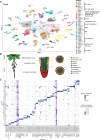Shoot and root single cell sequencing reveals tissue- and daytime-specific transcriptome profiles
- PMID: 34850215
- PMCID: PMC8825464
- DOI: 10.1093/plphys/kiab537
Shoot and root single cell sequencing reveals tissue- and daytime-specific transcriptome profiles
Abstract
Although several large-scale single-cell RNA sequencing (scRNAseq) studies addressing the root of Arabidopsis (Arabidopsis thaliana) have been published, there is still need for a de novo reference map for both root and especially above-ground cell types. As the plants' transcriptome substantially changes throughout the day, shaped by the circadian clock, we performed scRNAseq on both Arabidopsis root and above-ground tissues at defined times of the day. For the root scRNAseq analysis, we used tissue-specific reporter lines grown on plates and harvested at the end of the day (ED). In addition, we submitted above-ground tissues from plants grown on soil at ED and end of the night to scRNAseq, which allowed us to identify common cell types/markers between root and shoot and uncover transcriptome changes to above-ground tissues depending on the time of the day. The dataset was also exploited beyond the traditional scRNAseq analysis to investigate non-annotated and di-cistronic transcripts. We experimentally confirmed the predicted presence of some of these transcripts and also addressed the potential function of a previously unidentified marker gene for dividing cells. In summary, this work provides insights into the spatial control of gene expression from nearly 70,000 cells of Arabidopsis for below- and whole above-ground tissue at single-cell resolution at defined time points.
© The Author(s) 2021. Published by Oxford University Press on behalf of American Society of Plant Biologists.
Figures







References
-
- Apelt F, Breuer D, Nikoloski Z, Stitt M, Kragler F (2015) Phytotyping4D: a light‐field imaging system for non‐invasive and accurate monitoring of spatio‐temporal plant growth. Plant J 82: 693–706 - PubMed
-
- Birnbaum K, Shasha DE, Wang JY, Jung JW, Lambert GM, Galbraith DW, Benfey PN (2003) A gene expression map of the Arabidopsis root. Science 302: 1956–1960 - PubMed
-
- Brady SM, Orlando DA, Lee J-Y, Wang JY, Koch J, Dinneny JR, Mace D, Ohler U, Benfey PN (2007) A high-resolution root spatiotemporal map reveals dominant expression patterns. Science 318: 801–806 - PubMed
-
- Cheng CY, Krishnakumar V, Chan AP, Thibaud‐Nissen F, Schobel S, Town CD (2017) Araport11: a complete reannotation of the Arabidopsis thaliana reference genome. Plant J 89: 789–804 - PubMed
-
- De Rybel B, Vassileva V, Parizot B, Demeulenaere M, Grunewald W, Audenaert D, Van Campenhout J, Overvoorde P, Jansen L, Vanneste S (2010) A novel aux/IAA28 signaling cascade activates GATA23-dependent specification of lateral root founder cell identity. Curr Biol 20: 1697–1706 - PubMed
Publication types
MeSH terms
LinkOut - more resources
Full Text Sources
Other Literature Sources
Research Materials

